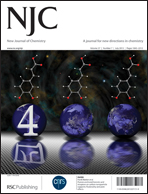Synthesis and characterization of 3-[(thiourea)-propyl]-functionalized silica gel and its application in adsorption and catalysis
Abstract
The objective of this research was the preparation of a silica gel functionalized successively with 3-chloropropyltrimethoxysilane (SG-PrCl) and thiourea (SG-Pr-THIO), and its application in adsorption and catalysis. The materials were characterized by 13C and 29Si NMR, FTIR, scanning electron micrographs (SEM), analysis of nitrogen and elemental analysis. Aiming at its application in adsorption, the [3-(thiourea)-propyl] silica gel (SG-Pr-THIO) was tested as an adsorbent for transition-metal ions using a batchwise process. The organofunctionalized surface showed the ability to adsorb the metal ions Cd(II), Cu(II), Ni(II), Pb(II) and Co(II) from water, ethanol and acetone. The adsorption isotherms were fitted by Langmuir, Freundlich, Temkin and Dubinin–Radushkevich (D–R) models. The kinetics of adsorption of metals were performed using three models such as pseudo-first order, pseudo-second order and Elovich. The Langmuir and pseudo-first order models were the most appropriate to describe the adsorption and kinetic data, respectively. With the purpose of application in catalysis, the SG-Pr-THIO was reacted with a Mo(II) organometallic complex, forming the new material SG-Pr-THIO-Mo. Only a few works in the literature have reported this type of reaction, and none dealt with thiourea and Mo(II) complexes. The new Mo-silica gel organometallic material was tested as catalyst in the epoxidation of cyclooctene and styrene.
![Graphical abstract: Synthesis and characterization of 3-[(thiourea)-propyl]-functionalized silica gel and its application in adsorption and catalysis](/en/Image/Get?imageInfo.ImageType=GA&imageInfo.ImageIdentifier.ManuscriptID=C3NJ00083D&imageInfo.ImageIdentifier.Year=2013)

 Please wait while we load your content...
Please wait while we load your content...